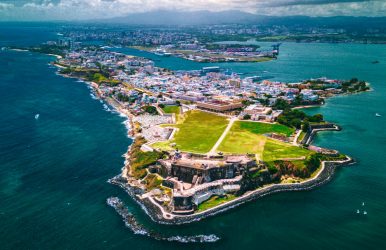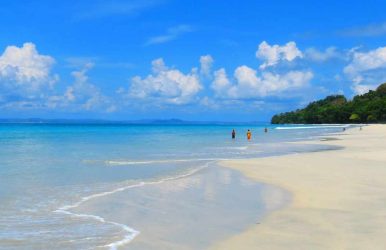Things To Do In San Juan, Puerto Rico For Free | Traveling On A Shoestring
BY Pijus Maity Nov 20, 2024
Puerto Rico is more than just a beach vacation. There is a reason why it is all over the internet, with a 22% surge in the search volume in 2024 (year-on-year). The UN Tourism report further highlights Puerto Rico as the second-most searched Caribbean destination. The tourism attractions in Puerto Rico are diverse, and there is a sincere attempt from the government to develop the tourism infrastructure. San Juan, the capital of Puerto Rico, has a vital role to play in the tourism boost of Puerto Rico. Along with being a stunning destination, San Juan also has vibrant street art and a happening neighborhood. Moreover, it is a quintessence of joie de vivre. Need more reasons to head to San Juan? It has many activities that will not charge you a single buck. Sounds fun, right? Let’s explore the best things to do in San Juan, Puerto Rico, for free. You Can Try The Following Things To Do In San Juan, Puerto Rico, For Free | Budget-Friendly Travel Ideas In The Caribbeans It will not be a jugglery of words if I call San Juan a “Caribbean Gem.” By the end of the 1800s, San Juan became a part of the USA. Further, San Juan, the capital of Puerto Rico, is the oldest city under the USA jurisdiction. Did You Know?Some airlines in Puerto Rico have increased their line of flights. Avelo Airlines is one of them and it has added a flight in “The Lakeland (LAL) – San Juan (SJU) route.” Further, it is the second route it has added to its itinerary outside the continental USA. The flight will have 20000 more seats, and this addition is expected to yield an economic impact of $6.3 million only in the first year of the line’s operations. This news corroborates the prospects and boost of tourism in San Juan.“The strengthening and expansion of air access to the island is key to the full development of the local tourism industry, so negotiations to attract new airlines and the increase in routes and frequencies is decisive for everyone. We share the enthusiasm of Avelo management with this new non-stop route since this new service between Puerto Rico and Florida will result in economic benefits for the entire tourism industry.”Carlos Mercado-Santiago, Executive Director, Puerto Rico Tourism Co. (PRTC) The city has rainforest, beaches with cobalt blue waters, century-old architecture, heritage, and of course, the things to do in San Juan, Puerto Rico, for free. So, why not try them? 1. Explore The Street Art In Santurce El Patio de Sole is a local restaurant on Calle Cerra and it is one of the highlights of Santruce, the most happening neighborhood of San Juan. Murals and larger-than-life art pieces by street artists have transformed this locality into a vibrant art gallery. Calle Loíza, the “Foodie and Arts Avenue” of Santruce, is another great place to explore street art here. Moreover, Aguacates and Las Musas are some of the best larger-than-life installations here. Did You Know?Almost 10 years back, San Juan, Santurce, and the entire Puerto Rico were going through an economic crisis. Through the Santurce Es Ley street art festival and the Color Libre engagement project, the street artists addressed social problems. 2. Enjoy Bird Feeding At Parque de las Palomas Parque de las Palomas is a public park and it is a place to relax amidst or after a tiring day at work. You can just sit on the benches overlooking the ocean and enjoy the cool breeze here. Further, feeding birds at Parque de las Palomas is one of the best things to do in San Juan, Puerto Rico, for free. This park is home to pigeons. You can collect bird seed from the park kiosk and feed these playful creatures. 3. Indulge In Street Food At Piñones Piñones on the beach bustle with local street foods. You can have fresh coconut here. Also, the alcapurrias and empanadas available at the local kiosks are amazing. Tour And Travel Note Don’t forget to get some honey and souvenirs from local vendors and artisans here. You can also take a stroll along the boardwalk or enjoy a bike ride in the mangrove forest. 4. Flying Kites At El Morro El Morro, a famous fort in San Juan, is located on the top of a hill, and it overlooks the bay. The grassy land in front of the fort is a big draw to the visitors. The high winds here make the grassy stretch ideal for flying kites. You can carry your own kites or buy one from the local vendors and enjoy your time with kids and the ones young at heart. 5. Sunbathing Playa Ocean Park, a hub of offshore reefs, is the highlight of Condado, the most popular beach in San Juan. Condado and all other beaches of Puerto Rico are free as those are public land. Further resorts like Condado Vanderbilt Hotel and La Concha make visiting Condado one of the best things to do in San Juan, Puerto Rico. Moreover, you can go kitesurfing or just relax on the beach and enjoy a sunbath. 6. Paseo De La Princesa Scenic Walk Paseo De La Princesa is an esplanade. This 19th-century promenade from the cruise port to El Morro fort stands out due to its European vibe. As you take a walk along Paseo De La Princesa, just outside the city wall, you will find large trees making arches. Further, the antique street lamps will grab the attention of any connoisseur. Moreover, you will find many food vendors as you enjoy the scenic walk. Are you travelling with your partner? Visit Paseo De La Princesa during sunset for the most romantic experience. 7. Experience The Best Of Night Life At La Placita De Santurce Do you want to experience the happening nightlife of San Juan? You must visit La Placita De Santurce after 9 PM as most of the bars here open after 9 or 10 PM and remain functional till early morning. Especially on the weekend, La Placita, or the famous market square, is the most vivacious with people on the street. Enjoy the Salsa moves and the grooviest reggaeton music. 8. Take A Walk In The San Juan Botanical Garden Operating Hours: 6 AM to 6 PM The San Juan Botanical Garden is a great place for the study of local plants and animals. The botanical garden is on the University of Puerto Rico campus. You can take a free entry here, and you also don’t need to pay any charges for parking. This is a great place to relax and exercise in San Juan. It is also perfect for a picnic. Moreover, you can explore the Japanese bridges and trails to make the most of your time here. 9. Pray At San Juan Cathedral Operating Hours: 8 AM to 4 PM (Sunday - Up to 2 PM) Mass Times: 7:25 AM and 12:15 PM on Weekdays, 7 PM on Saturdays, 9 AM and 11 AM on Sundays The Catedral de San Juan Bautista, or San Juan Cathedral, is the oldest church in the entire Western Hemisphere. Juan Ponce de Leon rests here, and the church also houses the mummified remains of a martyr from the first century, St. Pio. Attending the Noche Buena mass on 24th December is a one-of-a-kind experience at this church. To make the most of these fun and free things to do in San Juan, Puerto Rico, you need comfortable accommodation in the city. The table below has a list of some of the best hotels in San Juan with contact details. Hotel In San Juan, Puerto RicoContact Number Courtyard by Marriott Isla Verde Beach Resort+1 787-791-0404Residence Inn Isla Verde+1 787-961-1155Hyatt House San Juan+1 787-977-5000Dream Inn PR+1 787-200-6340Condado Vanderbilt Hotel +1 787-721-5500Tropica Beach Hotel+1 787-728-8119La Concha Renaissancece San Juan Resort+1 787-721-7500Dreamcatcher by DW+1 787-455-8259Hotel El Convento+1 787-723-9020AC Hotel San Juan Condado+1 787-827-7280 If you are planning to explore the best things to do in San Juan, contact any of the hotels first to book your accommodation. Also read Top 10 Most Popular Paraguay Food That You Must Try. Top 13+ Famous Wonders Of India That You Must Visit. Top Tips For Motorbike Rental In Phuket – A Guide To Exploring The Island On Two Wheels.













